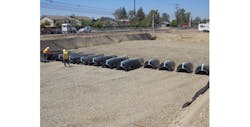Above and Below
Rialto, Calif.-based I-210 Logistics Center is part of a proposed master-planned project located at and around the Rialto Municipal Airport. The 1,445-acre site is a premier West Rialto location, with high-profile corporate neighbors such as Target, Under Armour, Black & Decker, Solo Cup and Kuehne + Nagel. The 718,000 sq-ft industrial distribution warehouse will house products until they are ready to be shipped to their final destinations across the country.
Upon completion, the Logistics Center will feature a cross-dock facility with 32-ft minimum warehouse clearance, 185- to 344-ft concrete truck courts, 112 dock loading doors (each 9 ft by 10 ft) and 249 trailer parking spaces, each measuring 10 ft by 53 ft. Approximately 3,380 sq ft of the building will be dedicated to the office space.
The challenge
In addition to designing the facility, engineers from SB&O Inc. collaborated with EW Harmon Contracting Inc. to design and install a storm water detention and retention system to comply with water quality requirements, as well as provide storm water pretreatment to the site.
Engineers determined that the most economically effective method of storm water management would be to combine an underground network of chambers with a separate aboveground system consisting of retention/detention basins—a relatively new practice. A challenging aspect of this dual-system design was determining how the two systems would interact with each other and how to keep siltation out of the underground system, into which water from the aboveground system migrates.
The solution
To mitigate water-quality concerns, engineers chose to raise the inlets in the aboveground detention basins so that the silts had a chance to settle prior to flowing into the underground chamber system, which consists of 726 Recharger V8HD units. Two CULTEC StormFilter 330 units filter runoff before it enters a CULTEC Separator Row. The StormFilter 330 is a chamber-shaped secondary filter that contains two removable pass-through filters. Water passes through the filter baffles and is captured or settles to the bottom of the unit. For maintenance, the StormFilter housing can be vacuumed out, and the filter bags may be replaced or cleaned and reused.
The Separator Row, comprised of the first row of underground chambers, pretreats runoff by capturing silts and fine particles in a row of chambers before runoff overflows into the rest of the infiltration basin. To help maintain the storm water system, debris can be easily vacuumed out using a water jet, which pushes water toward the catch basin and sump while removing waste.
The Recharger V8HD was selected for the Logistics Center because it both maximizes storage in a small footprint and satisfies the other design requirements of the site. The internal manifold feature available on the CULTEC storm water chamber allows for a more cost-effective and condensed bed size, since a costly and time consuming custom pipe and fitting external manifold fabrication is not required. Smaller chamber-like “feed connectors” are inserted into portals located on the sidewalls of the storm water chambers to create the internal manifold. Installation is quick and efficient.
Regulatory bodies called for a storm water solution that would mitigate the proposed flows to be equal to or less than the existing flows on site—particularly for higher-flow flood conditions. Moreover, to meet water quality regulations, a certain volume had to be retained onsite and infiltrated into the ground to accommodate lower-flow water quality requirements.
“Water flows into the aboveground detention/retention basins and fills about a foot deep before overflowing into the CULTEC chambers located underground,” said Don Brooks, an engineer with SB&O Inc. “The two systems combined provide the detention and retention volumes required to meet the regulatory requirements of the county.”
The results
The bed of chambers provides the site with a total of 72,857 cu ft of storage. In addition, the V8HD model is able to withstand traffic loading with minimal cover—a major site requirement, since the chambers will largely be covered with parking areas. Also, there is no underground storm drain system to tie into, so the runoff outlets are located to the street surface. For this reason, the engineers were eager to keep the storage elevation as high as possible to direct the flow to the street.
“This was our first time working with CULTEC, and we look forward to teaming up with them again in the future,” said Brooks. “Their team was very responsive and helped us get the job done quickly and efficiently.”


